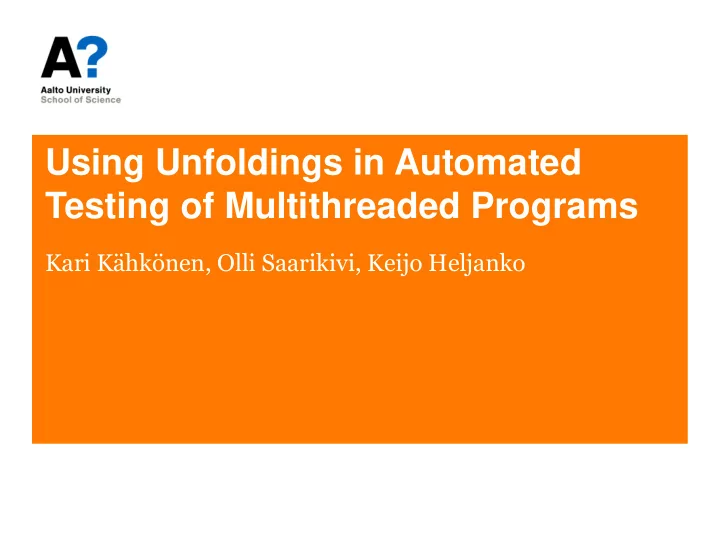

Using Unfoldings in Automated Testing of Multithreaded Programs Kari Kähkönen, Olli Saarikivi, Keijo Heljanko
The Problem • How to automatically test the local state reachability in multithreaded programs – E.g., find assertion violations, uncaught exceptions, etc. • The main challenge: path explosion and numerous interleavings of threads • One approach: dynamic symbolic execution (DSE) + partial order reduction • New approach: DSE + unfoldings
Dynamic Symbolic Execution • DSE aims to explore different execution paths of the program under test x = input x = x + 5 if (x > 10) { ... } ... Control flow graph
Dynamic Symbolic Execution • DSE typically starts with a random execution • The program is executed concretely and symbolically x = input x = x + 5 if (x > 10) { ... } ... Control flow graph
Dynamic Symbolic Execution • Symbolic execution generates constraints that can be solved to obtain new test inputs for unexplored paths c 1 c 2 x = input x = x + 5 c 3 c 4 if (x > 10) { ... } ... c 1 = input 1 + 5 > 10 c 2 = input 1 + 5 ≤ 10 Control flow graph
What about Multithreaded Programs? • Take control of the scheduler • Execute threads one by one until a global operation (e.g., access shared variable) is reached • Branch the execution tree for each enabled operation Scheduling decision
What about Multithreaded Programs? • Take control of the scheduler • Execute threads one by one until a global operation (e.g., access shared variable) is reached • Branch the execution tree for each enabled operation Problem: a large number of irrelevant interleavings
One Solution: Partial-Order Reduction • Ignore provably irrelevant parts of the symbolic execution tree • Existing algorithms: – dynamic partial-order reduction – race detection and flipping
Another Solution? • Can we create a symbolic representation of the executions that contain all the interleavings but in more compact form than with execution trees? • Yes, with unfoldings
What Are Unfoldings? • Unwinding of a control flow graph is an execution tree • Unwinding of a Petri net is an unfolding • Can be exponentially more compact than exec. trees Petri net Initial unfolding
What Are Unfoldings? • Unwinding of a control flow graph is an execution tree • Unwinding of a Petri net is an unfolding • Can be exponentially more compact than exec. trees Petri net Unfolding
What Are Unfoldings? • Unwinding of a control flow graph is an execution tree • Unwinding of a Petri net is an unfolding • Can be exponentially more compact than exec. trees Petri net Unfolding
What Are Unfoldings? • Unwinding of a control flow graph is an execution tree • Unwinding of a Petri net is an unfolding • Can be exponentially more compact than exec. trees Petri net Unfolding
What Are Unfoldings? • Unwinding of a control flow graph is an execution tree • Unwinding of a Petri net is an unfolding • Can be exponentially more compact than exec. trees Petri net Unfolding
Using Unfoldings with DSE • When a test execution encounters a global operation, extend the unfolding with one of the following events: read write lock unlock • Potential extensions for the added event are new test targets
Example Global variables: Thread 2: Thread 1: int x = 0; local int b = x; local int a = x; if (b == 0) if (a > 0) x = input(); error(); Initial unfolding
Example Global variables: Thread 2: Thread 1: int x = 0; local int b = x; local int a = x; if (b == 0) if (a > 0) x = input(); error(); First test run
Example Global variables: Thread 2: Thread 1: int x = 0; local int b = x; local int a = x; if (b == 0) if (a > 0) x = input(); error(); Find possible extensions
Example Global variables: Thread 2: Thread 1: int x = 0; local int b = x; local int a = x; if (b == 0) if (a > 0) x = input(); error();
Computing Potential Extensions • Finding potential extensions is the most computationally expensive part of unfolding • It is possible to use existing potential extension algorithms with DSE – Designed for arbitrary Petri nets – Very expensive • Key contribution: Possible to limit the search space of potential extensions due to restricted form of unfoldings generated by the algorithm – Same worst case behavior, but in practice very efficient
Comparison with DPOR and Race Detection and Flipping • The amount of reduction obtained by dynamic partial- order approaches depend on the order events are added to the symbolic execution tree • Unfolding approach is computationally more expensive per test run but typically requires less test runs – With threads that contains high amount of independence, the reduction to the number of test runs can be even exponential
Experiments DPOR (ACSD ’12) Unfolding jCUTE program paths time paths time paths Indexer (12) 8 2 85 10 8 Filesystem (16) 3 0 16 2 31 Filesystem (18) 4 0 97 6 2026 Parallel pi (5) 120 3 2698 17 120 Test selector (3) 65 2 87 2 65 Test selector (4) 2576 70 8042 97 2576 Pairs (6) 7 0 512 8 580 2520 2520 13 2520 Locking (4) 42 Synthetic-1 (3) 984 15 3716 10 2430 Synthetic-2 (3) 1943 54 7768 56 4860 Synthetic-3 (4) 682 14 8550 52 1757
Conclusions • A new approach to test multithreaded programs by combining DSE and unfoldings • The restricted form of the unfoldings allows efficient implementation of the algorithm • The new algorithm offers competitive performance to existing approaches – In some cases it can be substantially faster
Recommend
More recommend